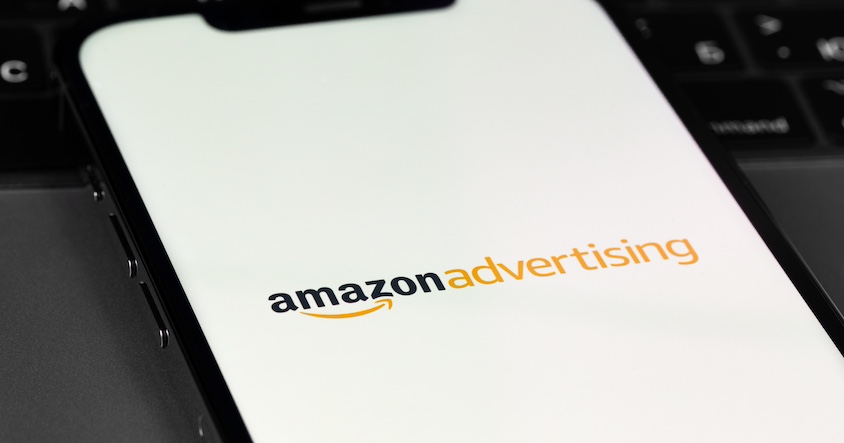Amazon Sponsored Products: How to place your products even before the organic search results

Every refined sales strategy on Amazon also includes advertisements. Sponsored Products Ads are among the most well-known formats – both among sellers, vendors, and customers. They belong to the PPC area of Amazon Advertising and promote a specific product through an ad in the search results for a particular keyword.
For less experienced online retailers or newcomers in the Amazon sector, the many different advertising formats of the trading platform can quickly become confusing. Therefore, we clarify here the most important questions about Sponsored Products in Amazon advertising: How do Sponsored Products work, how can sellers create them, and how can such campaigns be strategically used to increase the conversion rate?
What are Amazon Sponsored Products?
On Amazon, Sponsored Ads are well-known among customers and popular with sellers. They represent the third important component within Amazon PPC, alongside Sponsored Brands and Sponsored Display Ads. They are placed on the search results page, for example, between a Brand Ad and the first organic search results. However, placement within the organic results of a search results page or on a product detail page is also possible. Sponsored Products are very easily recognizable, simply by the fact that they are marked with the label “sponsored” under the product image on the left.

Characteristic of Sponsored Products ads on Amazon is that they always promote a specific product. Customers who click on such an advertisement will always be directed to the respective detail page. It is not possible to link to a different page. Furthermore, these ads are mostly keyword-based (Keyword Targeting). This means that an advertisement is displayed for a specific keyword. In the example above, for instance, four different listings of disposable masks are promoted for the keyword “mouth and nose protection.”
Successfully advertising on Amazon – Requirements
You benefit the most from your advertisement when it is displayed in the first position, thus having higher visibility than your competitors’ ads. The following requirements must be met for this:
Example case:
You sell mouth and nose protection masks and want to advertise these products on Amazon under the keyword “mouth and nose protection.” After researching the topic of PPC advertising on Amazon and analyzing your competitors’ strategies, you find that a competitor has bid 30 cents on the same keyword (“mouth and nose protection”). Therefore, you bid 31 cents and are favored by the algorithm. Additionally, you use repricing software that gives you a Buy Box share of up to 95%. After you have launched the advertisement, your ad competes with that of your competitor. However, your ad is favored by the algorithm, resulting in your masks selling better than those of the competition.
Why should sellers advertise their products at all?
The much-cited competition on Amazon is not exaggerated, as the trading platform operates on this basis: the excellent user experience has already attracted millions of customers, and more are coming, which in turn encourages sellers to sell through Amazon as well. The increased selection improves the customer experience – and the cycle starts all over again.
This also means: As a search engine for products, Amazon is becoming increasingly important. At the same time, sellers are finding it more difficult to place their listings visibly. High visibility is a prerequisite for sales and thus success on Amazon. Sponsored Products and other PPC campaigns can effectively increase this visibility. In addition to solid SEO, sponsored products are therefore an important component of the sales strategy to increase market share and revenue.
In addition, Amazon Sponsored Products Ads also serve well during the launch of a product. Here, too, the primary goal is to increase its visibility – after all, new products have no reviews and no or only a poor ranking. Advertising can improve both.

However, Amazon sellers should not create Sponsored Products Ads individually for just one or another product. To generate maximum success, a refined strategy and the combination with other advertising formats are needed. In any case, a comprehensive keyword research must be conducted first.
In addition, there are different match types, known as “Match Types,” that determine how high the match between the keyword and the search term for the advertisement can be. If the advertiser chooses the broad match type, many search terms are covered with relatively little effort. However, this affects precision, and the conversion rate decreases. Exact match types are more precise but also require more effort.
More information on the topic of PPC strategy and the setup of Sponsored Products advertising campaigns can be found here: “Structuring Sponsored Products Ads Correctly”.
What do these ads cost on Amazon?
Amazon Sponsored Products are allocated using the PPC method. “Pay per Click” means that the advertiser does not pay for merely displaying the advertisement (so-called impressions), but only when a customer actually clicks on the ad. However, it is impossible to provide a general answer regarding the total cost of Amazon Sponsored Products ads or campaigns and what the standard bid per click (Cost per Click / CPC) is, as this depends on several variable factors.
First of all, each advertiser places a bid on how much they are willing to pay for a click, for example, €0.45. The highest bidder wins the contract and occupies the first ad position. Therefore, how much a click ultimately costs depends significantly on one’s own bid and the bids of other sellers. The higher the competition for a specific keyword, the higher the click price usually rises, along with the standard bid.
Amazon Sponsored Products vs. Sponsored Brands on Amazon
The differentiation between Sponsored Products and Sponsored Brands often causes confusion. The differences mainly lie in the structure of the ad, the linking, and the advertising purpose:
Product Targeting with Sponsored Products Campaigns
Since 2020, Amazon Advertising has also offered Product Targeting for Sponsored Products Ads. The difference from keyword-based targeting is that ads can be directed towards products, brands, product categories, and other product features through Product Targeting. However, the billing model and the possible placements of the ad on Amazon remain the same. Ads with Product Targeting are, however, displayed more frequently on detail pages than keyword-based campaigns.
The applications of Amazon Sponsored Products with Product Targeting are diverse, especially in cross-selling, protecting one’s own brand, and brand awareness:
Dynamic eCommerce Ads on Amazon
With Amazon Dynamic eCommerce Ads, advertisers have another tool available for increasing revenue. Although this ad format belongs to the Demand Side Platform (DSP) and is therefore not directly part of Amazon Sponsored Products, we will briefly address it here, as the Dynamic Ad also promotes a single product and looks very similar to the Sponsored Products Ad. In contrast to this, the Dynamic eCommerce Ad is based on retargeting and can also be displayed in apps or on external third-party websites.
In retargeting, collected data about customer behavior is analyzed and used as the basis for ad display. If a user, for example, has viewed a specific brand or product, they can be reminded a few days later through a Dynamic eCommerce Ad that they are interested in it, thereby increasing the likelihood that the customer will actually make the purchase. This makes retargeting particularly suitable for directing external traffic to the product detail page (back).
Conclusion: Diverse Advertising Opportunities with Amazon Sponsored Products
Sponsored Products are rightly the most popular advertising format in Amazon’s advertising ecosystem. They can both boost the sales of existing products and increase the visibility of a newly launched product. When strategically used in advertising campaigns, they significantly contribute to enhancing the visibility and profitability of a product.
The various display options are particularly interesting: Instead of keyword targeting, Sponsored Products can also be displayed using product targeting. Through Amazon DSP’s Dynamic eCommerce Ad, retargeting is even possible.
Another advantage is that through the PPC method, usually only clicks are paid for, not impressions. This allows even PPC beginners to have control over their advertising budget and to carefully consider how much they are willing to pay for a click.
FAQs
Amazon Sponsored Products are a PPC advertising option for sellers on Amazon. They allow for prominent placement of products in search results and on product detail pages.
Amazon sellers bid on keywords to place their ads in search results and on product detail pages. The ads are delivered based on relevant keyword searches and the seller’s budget. Sellers only pay when a customer clicks on the ad.
Whoever pays more for the keyword gets higher visibility. At this point, even a minimal cent amount is sufficient. Additionally, Amazon sellers must also have the advertised product in Buy Box.
1. Go to your Amazon Seller Central account.
2. Click on the “Advertising” tab.
3. Select the “Manage Campaigns” option or a similar option (Amazon frequently changes the wording in Seller Central).
4. Disable the running advertising campaigns by clicking on the respective campaign and then selecting the option to deactivate.
5. Regularly check your advertising accounts to ensure that no new campaigns are activated.
Image credits in the order of the images: © funstarts33 – stock.adobe.com / © Screenshot @ Amazon / © Gecko Studio – stock.adobe.com / © Screenshot @ Amazon









